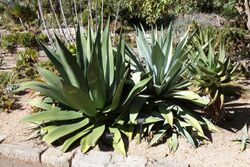Biology:Agave salmiana
| Agave salmiana | |
|---|---|

| |
| Agave salmiana in San Francisco Botanical Garden | |
| Scientific classification | |
| Kingdom: | Plantae |
| Clade: | Tracheophytes |
| Clade: | Angiosperms |
| Clade: | Monocots |
| Order: | Asparagales |
| Family: | Asparagaceae |
| Subfamily: | Agavoideae |
| Genus: | Agave |
| Species: | A. salmiana
|
| Binomial name | |
| Agave salmiana Otto ex Salm-Dyck[2]
| |
| Synonyms[3][4] | |
| |
Agave salmiana (also known as maguey pulquero and green maguey)[5] is a species of the family Asparagaceae, native to central and southern Mexico. It is also reportedly naturalized in South Africa, Italy and Spain, specially in the Canary Islands.[6][7]
This species, also called agave of Salm or Salm-Dick, is dedicated to the German prince and botanist Joseph zu Salm-Reifferscheidt-Dyck (1773-1861).[citation needed]
Description
Agave salmiana presents a spiral-shaped rosette with large flared and erect leaves. These leaves are thick, dark green with a large point at the tip and strong spines on the edges. When a leaf has unfolded, it leaves an imprint on the leaf underneath.
Like most agaves, the species is monocarpic, that is to say it only flowers once and then dies. This flowering occurs after 15 to 25 years producing a vertical floral stem, typically up to 4 m (13 ft) long and bearing greenish-yellow flowers. The largest specimens have been significantly taller. One specimen growing at the Strawberry Canyon Botanical Garden on the campus of U. C. Berkeley, Berkeley, California in 1974 produced an inflorescence with a total height of 52 feet (16 m) of which the scape or peduncle was about 39 ft 4 in (11.99 m) and the panicle per se was 13 feet (4.0 m).[8] Hermann J.H. Jacobsen states that the inflorescence of A. salmiana has reached an overall height of 62 feet (19 m),[9] making the inflorescence of A. salmiana the tallest of any known species of plant.
Old plants reach 1.8 m in height and the leaves form a rosette 3.6 m in diameter.
The variety A. salmiana var. ferox is often encountered in cultivation. The epithet ferox is due to the hard and long (up to 8 cm) spines.
Distribution
Originally from southern and central Mexico, it was introduced into gardens with a Mediterranean climate in Europe and sometimes escaped into the wild, thus becoming naturalised in some parts of southern Europe.
Cultivation
Cultivation is easy in a well-drained sandy soil with sunny exposure. For a pot culture, it requires a container of very large size to remain in a harmonious appearance. It can be used to stabilise a slope. It can withstand a light frost if it is completely dry. It is multiplied more easily by planting shoots than by seedlings.
References
- ↑ García-Mendoza, A.J.; Sandoval-Gutiérrez, D.; Hernández Sandoval, L.; Puente, R.; Zamudio, S.; González-Elizondo, M.; Hernández-Martínez, M. (2019). "Agave salmiana". IUCN Red List of Threatened Species 2019: e.T115690583A116354428. doi:10.2305/IUCN.UK.2019-3.RLTS.T115690583A116354428.en. https://www.iucnredlist.org/species/115690583/116354428. Retrieved 20 November 2021.
- ↑ World Checklist of Selected Plant Families, The Board of Trustees of the Royal Botanic Gardens, Kew, http://apps.kew.org/wcsp/home.do, retrieved 2011-09-26, search for "Agave salmiana"
- ↑ Tropicos Agave salmiana
- ↑ The Plant List, Agave salmiana
- ↑ Cortés Zárraga, Laura; Basurto Peña, Francisco. "Agave salmiana Otto ex Salm." (in Spanish). Grupo Etnobotánico Latinoamericano. http://www.ibiologia.unam.mx/gela/pp-1.html. Retrieved 9 July 2020.
- ↑ Salm-Reifferscheid-Dyck, Joseph Franz Maria Anton Hubert. Bonplandia 7: 88. 1859.
- ↑ Howard Scott Gentry, Agaves of Continental North America (University of Arizona Press, 1982) pp. 183-1850
- ↑ Norris and Ross McWhirter, GUINNESS BOOK OF WORLD RECORDS (New York: Sterling Pub. Co., 1989 edit.) p. 75. And a letter from Bruce Bartholomew, Curator of the Strawberry Canyon Botanic Garden.
- ↑ Hermann Jacobsen, HANDBOOK OF SUCCULENT PLANTS (London: Blandford Press, 1960) Vol. 1 p. 118.
Wikidata ☰ Q3028235 entry
 |


